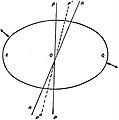File:EB1911 Latitude.jpg
EB1911_Latitude.jpg (492 × 497 pixels, file size: 28 KB, MIME type: image/jpeg)
File history
Click on a date/time to view the file as it appeared at that time.
| Date/Time | Thumbnail | Dimensions | User | Comment | |
|---|---|---|---|---|---|
| current | 18:49, 9 July 2019 |  | 492 × 497 (28 KB) | Bob Burkhardt | {{Information |description ={{en|1=''Variability of Terrestrial Latitudes''.—The latitude of a point on the earth's surface, as above defined, is measured from the equator. The latter is defined by the condition that its plane makes a right angle with the earth's axis of rotation. It follows that if the points in which this axis intersects the earth's surface, i.e. the poles of the earth, change their positions on the earth's surface, the position of the equator will also change, and theref... |
File usage
The following 2 pages use this file:

